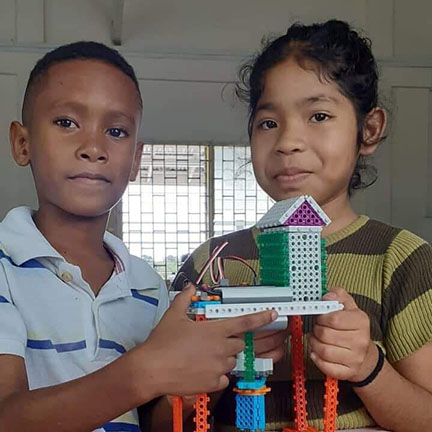Very much with the 2017 10th place outcome for the Guyana team in the first ever Global Robotics Competition, the local STEM Guyana organization has announced that it is in the process of preparing two teams to participate in junior and senior international Robotics competitions in Dubai and South Korea later this year.
In an interview with Stabroek Business earlier this week, co-founder of STEM Guyana, Karen Abrams said that the surprising outcome of Guyana’s participation in the Washington event had provided the impetus for the decision to prepare for participation in the two forthcoming events. Abrams said however that while she was satisfied that the training exercises were going well she could not say that participation in the two events was “a done deal” since there was still the question of meeting the costs associated with getting the teams to the two countries and financing their stay and other costs associated with participation.
During an exchange with this newspaper at the Cliff Anderson Sports Hall where local STEM events usually take place, Abrams said that the preparations were proceeding “out of an abundance of faith since we really have no way of knowing at this stage how participation in the two events is going to be financed.” She believes the keenness of what she describes as “the Caribbean’s fastest growing STEM programme for children” and “three years of amazing growth and success,” has kept the young STEM enthusiasts focused and hopeful that they will participate in Dubai and South Korea.
According to Abrams while STEM Guyana was “more than happy” with the extent to which it had raised countrywide awareness of the disciplines associated with the STEM disciplines and robotics it was “somewhat disappointed” over the fact that after three years the organization “still operates out of a tiny clubhouse at the Cliff Anderson Sports Hall while running a year round national programme with no guaranteed funding or national budget. Frankly, while we are only too well aware of the various other priorities confronting a country such as ours we would wish to get that much more attention from both the public and private sectors as far as material support is concerned”.
She said that even as the organization continues to ponder its fund-raising challenges the teams meet to analyze the challenges issued by the tournament organizers and to design, redesign, build and rebuild their competition robots. “The young people involved are vocal, confident, problem solvers. They are citizens of the world, they view problems as opportunities to innovate, they love working together, they rely on each other and among them there is a clear understanding of the challenges before them and an enthusiasm to solve them. They have more than earned the right to be part of these competitions,” Abrams says.
Abrams told Stabroek Business that up until this time organizations like the Ministry of Public Telecommunications, the Office of the First Lady, the Guyana Telephone & Telegraph Company the Department of Youth and ExxonMobil have served as “literal lifelines” for the national STEM programme. “These organizations understand the importance of preparing the next generation of the nation’s children to compete on a level global playing field. They understand that technology education today is an investment in the quality of the work force of the future.” Abrams says that one of STEM Guyana’s “absolute priorities” is to embrace the local Ministry of Education as one of its principal partners. “We got support from the Ministry for the national team in 2017 and 2018 and we’re hopeful that some level of support for 2019 will be finalized soon.”
Abrams told Stabroek Business that contrary to what might well be popular belief, Guyana was not the only poor country that was seeking to participate in this year’s international robotics competitions. “We expect that180 countries will participate in these tournaments in 2019. Many of them do not have the resources that we do in Guyana, but they will participate because local stakeholders take pride in their participation and believe in the investment in the future. We are confident that our stakeholders will also support our young people. We are moving forward on faith”
Currently, STEM Guyana, through its various public and private partnerships prepare curricula, training and STEM Club opportunities for children in eight of the country’s administrative regions through more than 50 STEM clubs. STEM Guyana is also involved in the training of Club Leaders and is engaged in more than forty outreach programmes annually. The organization also runs a national robotics competition to ensure full engagement and fun for young club members across the nation. In addition to its funding challenges the organization’s other challenges include finding an adequate location for office and training, standardizing programme quality across local STEM clubs countrywide and rolling out the programmes to all ten of the country’s administrative regions. Abrams insists, however, that the Guyana STEM programme will survive and grow “as long as it is continues to be embraced and supported by parents, children and good partners. Our vision looks out fifteen to twenty years, and we are confident that the primary and secondary school children in our programme today will add to the exponential growth and development of this country and this region,” Abrams told Stabroek Busines.






